#Keypoint detection
Explore tagged Tumblr posts
Text
https://pixelannotation.com/how-keypoint-annotation-works-pose-estimation-human-tracking/
0 notes
Text
Title: Image Annotation Services Explained: Tools, Techniques & Use Cases
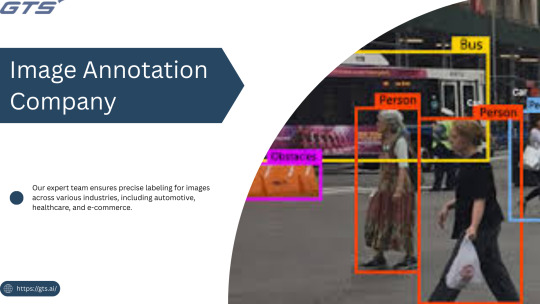
Introduction
In the fast-paced realm of artificial intelligence, Image Annotation Company serve as the foundation for effective computer vision models. Whether you are creating a self-driving vehicle, an AI-driven medical diagnostic application, or a retail analytics solution, the availability of high-quality annotated images is crucial for training precise and dependable machine learning models. But what precisely are image annotation services, how do they function, and what tools and methodologies are utilized? Let us explore this in detail.
What Is Image Annotation?
Image annotation refers to the practice of labeling or tagging images to facilitate the training of machine learning and deep learning models. This process includes the identification of objects, boundaries, and features within images, enabling AI systems to learn to recognize these elements in real-world applications. Typically, this task is carried out by specialized image annotation firms that employ a combination of manual and automated tools to guarantee precision, consistency, and scalability.
Common Image Annotation Techniques
The appropriate annotation method is contingent upon the specific requirements, complexity, and nature of the data involved in your project. Among the most prevalent techniques are:
Bounding Boxes:
Utilized for identifying and localizing objects by encasing them in rectangular boxes, this method is frequently applied in object detection for autonomous vehicles and security systems.
Polygon Annotation:
Best suited for objects with irregular shapes, such as trees, buildings, or road signs, this technique allows for precise delineation of object edges, which is essential for detailed recognition tasks.
Semantic Segmentation:
This approach assigns a label to every pixel in an image according to the object class, commonly employed in medical imaging, robotics, and augmented/virtual reality environments.
Instance Segmentation:
An advancement over semantic segmentation, this method distinguishes between individual objects of the same class, such as recognizing multiple individuals in a crowd.
Keypoint Annotation:
This technique involves marking specific points on objects and is often used in facial recognition, human pose estimation, and gesture tracking.
3D Cuboids:
This method enhances depth perception in annotation by creating three-dimensional representations, which is vital for applications like autonomous navigation and augmented reality.
Popular Image Annotation Tools
Image annotation can be executed utilizing a diverse array of platforms and tools. Notable examples include:
LabelImg: An open-source tool designed for bounding box annotations,
CVAT: A web-based application created by Intel for intricate tasks such as segmentation and tracking,
SuperAnnotate: A robust tool that merges annotation and collaboration functionalities,
Labelbox: A comprehensive platform featuring AI-assisted labeling, data management, and analytics,
VGG Image Annotator (VIA): A lightweight tool developed by Oxford for efficient annotations.
Prominent annotation service providers like GTS.AI frequently employ a blend of proprietary tools and enterprise solutions, seamlessly integrated with quality assurance workflows to fulfill client-specific needs.
Real-World Use Cases of Image Annotation
Image annotation services play a vital role in various sectors, including:
Autonomous Vehicles
Object detection for identifying pedestrians, vehicles, traffic signs, and road markings.
Lane detection and semantic segmentation to facilitate real-time navigation.
Healthcare
Annotating medical images such as X-rays and MRIs to identify tumors, fractures, or other abnormalities.
Training diagnostic tools to enhance early disease detection.
Retail and E-commerce:
Implementing product identification and classification for effective inventory management.
Monitoring customer behavior through in-store camera analytics.
Agriculture:
Assessing crop health, detecting pests, and identifying weeds using drone imagery.
Forecasting yield and optimizing resource allocation.
Geospatial Intelligence:
Classifying land use and mapping infrastructure.
Utilizing annotated satellite imagery for disaster response.
Why Work with a Professional Image Annotation Company?
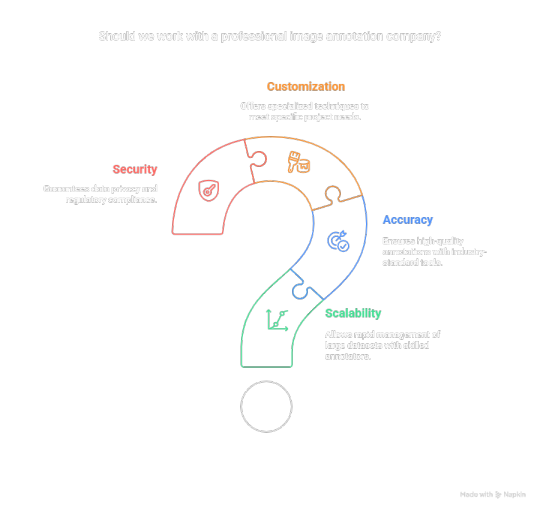
Although in-house annotation may initially appear feasible, expanding it necessitates significant time, resources, and a comprehensive quality assurance process. This is the reason businesses collaborate with providers such as GTS.AI:
Scalability : Allows for the rapid management of extensive datasets through skilled annotators;
Accuracy : Is ensured with industry-standard tools and quality assurance measures;
Customization : Coffers specialized annotation techniques to meet specific project objectives; and
Security : Guarantees adherence to data privacy regulations for sensitive data.
Final Thoughts
With the expansion of AI and computer vision applications, the necessity for high-quality annotated data has become increasingly vital. Image annotation services have evolved from being merely supportive functions to becoming strategic assets essential for developing dependable AI systems. If you aim to enhance your AI projects through professional data labeling, consider Globose Technology Solution .AI’s Image and Video Annotation Services to discover how they can effectively assist you in achieving your objectives with accuracy, efficiency, and scalability.
0 notes
Text

Reliable Data Labeling Services for Animal Recognition Models
Wisepl deliver high-quality, pixel-perfect data annotation services for Animal Detection that supercharge your AI models with unparalleled accuracy. Our expert annotators ensure every dataset is labeled with precision, making your machine learning models smarter, faster, and more reliable!
Why Choose Wisepl?
. Expert Human Annotation – No Auto-Labeling, Pure Accuracy. . 1M+ Bounding Boxes Completed – Proven Expertise & Speed . Custom Annotation Types – Bounding Boxes, Polygons, Keypoints & More . Scalable Solutions – From Small Projects to Large-Scale AI Training . Fast Turnaround – On-Time Delivery, Every Time
Whether you're working on wildlife monitoring, autonomous farming, pet recognition, or AI-driven animal behavior analysis, we've got the annotation expertise to make your project a success.
Contact us now to discuss your project needs www.wisepl.com | [email protected]
#DataAnnotation#AITraining#MachineLearning#AnimalDetection#SmartAI#AIInnovation#DeepLearning#ArtificialIntelligence#Wisepl#AIDataLabeling#AIModels#ComputerVision#TechForGood#BigData#AIforWildlife#DataDriven#AnnotationExperts#AIService#WildlifeAI#MLSolutions
0 notes
Text
Data Collection Through Images: Techniques and Tools
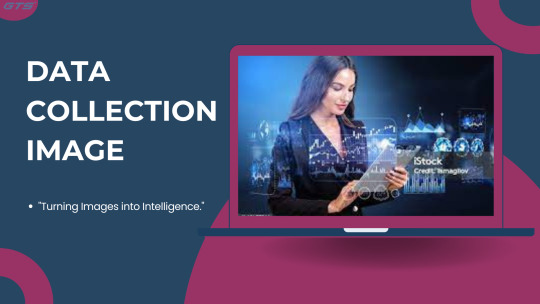
Introduction
In the contemporary landscape driven by data, the Data Collection Images -based data has emerged as a fundamental element across numerous sectors, including artificial intelligence (AI), healthcare, retail, and security. The evolution of computer vision and deep learning technologies has made the gathering and processing of image data increasingly essential. This article delves into the primary methodologies and tools employed in image data collection, as well as their significance in current applications.
The Importance of Image Data Collection
Image data is crucial for:
Training AI Models: Applications in computer vision, such as facial recognition, object detection, and medical imaging, are heavily reliant on extensive datasets.
Automation & Robotics: Technologies like self-driving vehicles, drones, and industrial automation systems require high-quality image datasets to inform their decision-making processes.
Retail & Marketing: Analyzing customer behavior and enabling visual product recognition utilize image data for enhanced personalization and analytics.
Healthcare & Biometric Security: Image-based datasets are essential for accurate medical diagnoses and identity verification.
Methods for Image Data Collection
1. Web Scraping & APIs
Web scraping is a prevalent technique for collecting image data, involving the use of scripts to extract images from various websites. Additionally, APIs from services such as Google Vision, Flickr, and OpenCV offer access to extensive image datasets.
2. Manual Image Annotation
The process of manually annotating images is a critical method for training machine learning models. This includes techniques such as bounding boxes, segmentation, and keypoint annotations.
3. Crowdsourcing
Services such as Amazon Mechanical Turk and Figure Eight facilitate the gathering and annotation of extensive image datasets through human input.
4. Synthetic Data Generation
In situations where real-world data is limited, images generated by artificial intelligence can be utilized to produce synthetic datasets for training models.
5. Sensor & Camera-Based Collection
Sectors such as autonomous driving and surveillance utilize high-resolution cameras and LiDAR sensors to gather image data in real-time.
Tools for Image Data Collection
1. Labeling
A widely utilized open-source tool for bounding box annotation, particularly effective for object detection models.
2. Roboflow
A robust platform designed for the management, annotation, and preprocessing of image datasets.
3. OpenCV
A well-known computer vision library that facilitates the processing and collection of image data in real-time applications.
4. Super Annotate
A collaborative annotation platform tailored for AI teams engaged in image and video dataset projects.
5. ImageNet & COCO Dataset
Established large-scale datasets that offer a variety of image collections for training artificial intelligence models.
Where to Obtain High-Quality Image Datasets
For those in search of a dataset for face detection, consider utilizing the Face Detection Dataset. This resource is specifically crafted to improve AI models focused on facial recognition and object detection.
How GTS.ai Facilitates Image Data Collection for Your Initiative
GTS.ai offers premium datasets and tools that streamline the process of image data collection, enabling businesses and researchers to train AI models with accuracy. The following are ways in which it can enhance your initiative:
Pre-Annotated Datasets – Gain access to a variety of pre-labeled image datasets, including the Face Detection Dataset for facial recognition purposes.
Tailored Data Collection – Gather images customized for particular AI applications, such as those in healthcare, security, and retail sectors.
Automated Annotation – Employ AI-driven tools to efficiently and accurately label and categorize images.
Data Quality Assurance – Maintain high levels of accuracy through integrated validation processes and human oversight.
Scalability and Integration – Effortlessly incorporate datasets into machine learning workflows via APIs and cloud-based solutions.
By utilizing GTS.ai, your initiative can expedite AI training, enhance model precision, and optimize image data collection methods.
Conclusion
The collection of image-based data is an essential aspect of advancements in Globose Technology Solutions AI and computer vision. By employing appropriate techniques and tools, businesses and researchers can develop robust models for a wide range of applications. As technology progresses, the future of image data collection is poised to become increasingly automated, ethical, and efficient.
0 notes
Text
Enhancing the Accuracy of AI Models through Superior Image Annotations.
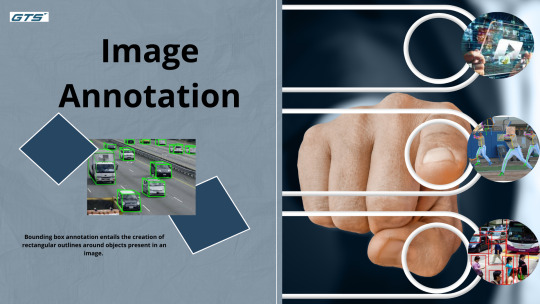
Introduction:
In the era of artificial intelligence and machine learning, image annotation is essential for enabling machines to perceive and comprehend the world in a manner akin to human understanding. This capability is vital for applications ranging from autonomous vehicles to facial recognition technologies and medical diagnostics, as the effectiveness of AI models in interpreting images is significantly dependent on the quality of the annotation provided.
What is Image Annotation?
Image Annotation refers to the practice of assigning metadata to images to facilitate the training of machine learning models. By identifying and labeling objects, regions, or characteristics within an image, annotation aids AI systems in recognizing patterns, distinguishing objects, and generating accurate predictions.
Various annotation techniques include:
Bounding Boxes: Enclosing objects within rectangles to assist AI in their detection.
Semantic Segmentation: Classifying each pixel in an image for detailed analysis.
Polygons and Key Points: Employed for identifying irregular shapes and landmarks in facial recognition tasks.
3D Cuboids: Assists AI models in grasping depth and the dimensions of objects.
Polyline Annotation: Utilized in lane detection for self-driving vehicles.
Why is Image Annotation Important?
Without adequately labeled data, machine learning models face challenges in effectively learning patterns. High-quality annotation guarantees:
Improved Accuracy: Superior training data results in more accurate AI predictions.
Enhanced Automation: Facilitates AI-driven automation across various sectors, including healthcare, retail, and transportation.
Safety and Reliability: Crucial for AI applications such as autonomous vehicles, where precision is paramount.
Types of Image Annotation Techniques
A variety of annotation techniques address distinct needs and complexities associated with image data.
Bounding Box Annotation
Bounding box annotation entails the creation of rectangular outlines around objects present in an image. This method is extensively utilized for object detection tasks, facilitating the identification and localization of objects within a scene. Bounding boxes are particularly advantageous for detecting objects with regular geometries and are computationally efficient for training models.
Semantic Segmentation
Semantic segmentation involves assigning a class label to each individual pixel in an image, which allows for a comprehensive understanding of the scene. This technique is vital for applications that demand precise localization, such as autonomous driving, where it is critical to differentiate between roads, sidewalks, and obstacles. Semantic segmentation offers pixel-level classification, enabling models to grasp the context and interrelations among various objects within an image.
Polygon Annotation
Polygon annotation consists of delineating objects with irregular shapes by utilizing a series of connected points to form a polygonal boundary. This approach provides enhanced accuracy for annotating complex objects compared to bounding boxes, as it closely adheres to the contours of the object. Polygon annotation is particularly useful for tasks that require precise object localization, such as in medical imaging and satellite imagery analysis.
Keypoint Annotation
Keypoint annotation identifies specific points of interest within an object, such as facial landmarks (eyes, nose, mouth) or joint positions in human pose estimation. This technique is crucial for applications like facial recognition, gesture recognition, and activity analysis, where understanding the spatial arrangement of key features is essential.
Cuboid Annotation
Cuboid annotation expands bounding boxes into three dimensions, offering depth information regarding objects.
Numerous sectors gain advantages from image annotation, such as:
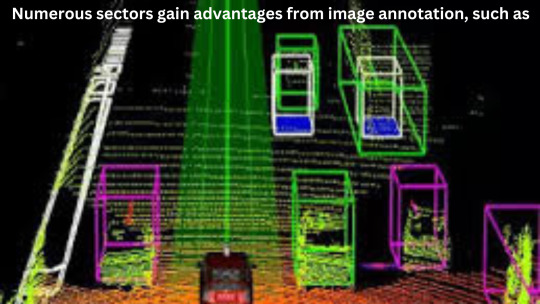
Healthcare: AI-driven diagnostics, tumor identification, and analysis of medical imaging.
Autonomous Vehicles: Lane identification, recognition of pedestrians, and detection of obstacles.
Retail and E-commerce: Visual search capabilities, product classification, and virtual fitting experiences.
Agriculture: Monitoring of crops, identification of pests, and forecasting of yields.
Selecting an Appropriate Image Annotation Partner
For organizations aiming to incorporate AI, collaborating with a specialized annotation service like GTS AI can significantly enhance outcomes. Professional annotation services offer:
Scalability: Efficient management of extensive data volumes.
Quality Assurance: Guaranteeing accurate and uniform annotations.
Security and Compliance: Safeguarding sensitive information through adherence to industry-standard security protocols.
Conclusion
Image annotation serves as the cornerstone of advancements in computer vision and AI. Whether engaged in medical AI, autonomous vehicle technology, or e-commerce solutions, high-quality annotation is crucial for optimal AI model performance. Investing in expert annotation services enables businesses to fully harness the potential of AI and maintain a competitive Globose Technology Solutions.
0 notes
Text
#musk #dont #cut : #armedforces #modern_capabilities .@us_stratcom @us_stratcom @usnavy .@usnavy . @lockheedmartin .@northropgrumman .@elonmusk @elonmusk @dogecoindesigner .@potus @potus @gop .@gop @dn c .@nato @nato @otan .@boeingdefense .@usairforce @usairforce .@raf .@royalnavy @warship_78 6thgen fighters climing high getting more possibilities with practicallydeployable munitions at scale and 5th gen figther s with their sensorsfusion require special directed energy weapons which #keypoint force drone menace capability into such high cost tha t their number is reduced tobe effective while thereisno shortcut for concentrationof firepower #keypoint the extension of drone defense as mobile airborne platforms without expending munitions forcing capability necessities evenmore with highpowered naval systems vulnerable needing more extensions of dronesafety the detection of stealth over lidar systems is an upcoming nobrai ner attempted recent decade by adversaries that mission necessary roles of concentional wars like interdiction and deepstrike sead/dead and dronefreehunt imply high firepowe r requirements which cruisemissiles as only feasible option lead to how interceptable capabilities per costs ************ #keypoint #critical the securing of airdominance against drones forcing their capabilities costup toreducenumber with under su pplied ammo of intercepting friendlies atcore evenmore with vulnerable but already highlypowered navalsytems while at the sametime the counterstrike capability requires vast amounts of precise ranged firepower ************ itis not thatmuch a manned vs unmanned question : thatis a too narrow aspect mind that no doge becomes efficiency inspired by exploiting lacki ng f o r m e r armedforced layout armedforces concepts to n o w cut the wrong things
#musk #dont #cut : #armedforces #modern_capabilities .@us_stratcom @us_stratcom @usnavy .@usnavy .@lockheedmartin .@northropgrumman .@elonmusk @elonmusk @dogecoindesigner .@potus @potus @gop .@gop @dnc .@nato @nato @otan .@boeingdefense .@usairforce @usairforce .@raf .@royalnavy @warship_78 6thgen fighters climing high getting more possibilities with practicallydeployable munitions at scale and…
0 notes
Text
The Role of Image Labeling in AI: Why It Matters
Artificial Intelligence (AI) has become a crucial technology across multiple industries, enabling automation, decision-making, and problem-solving. However, the success of AI depends on high-quality training data. For AI models to recognize objects, detect patterns, and make accurate predictions, they need labeled images. Image labeling is the process of adding metadata, tags, or annotations to images, allowing AI to understand visual data effectively.
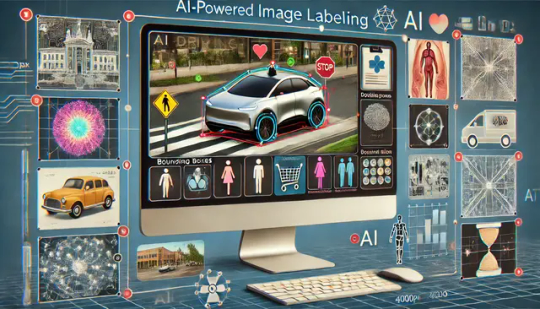
Without proper image labeling, AI models would struggle to differentiate between objects, leading to unreliable results. This article explores the importance of image labeling, the challenges in the process, and how businesses can optimize their AI workflows with advanced tools.
What Is Image Labeling?
Image labeling is a process in which images are annotated with relevant information, making them easier for AI models to interpret. This is a critical step in training machine learning models for applications such as autonomous driving, medical imaging, and security surveillance.
Common types of image labeling include:
Bounding Boxes: Drawing rectangles around objects to help AI detect them.
Segmentation: Dividing an image into multiple sections to differentiate objects.
Object Classification: Assigning images to predefined categories based on their content.
Keypoint Annotation: Marking specific points on an image, commonly used in facial recognition and motion tracking.
For example, in self-driving cars, labeled images help AI recognize pedestrians, road signs, and vehicles. In healthcare, AI models trained with labeled medical images assist doctors in diagnosing diseases.
Why Is Image Labeling Important for AI?
Enhances AI Model AccuracyAI models learn from labeled data. The more accurately an image is labeled, the better the AI model performs in real-world applications. Poorly labeled data can lead to incorrect predictions.
Reduces AI BiasIf an AI model is trained on biased data, it can produce inaccurate or unfair outcomes. A well-labeled and diverse dataset ensures AI makes more balanced decisions.
Enables AI-Powered AutomationMany industries, such as retail, agriculture, and autonomous driving, use AI for automation. Labeled images allow AI models to recognize objects and take appropriate actions.
Speeds Up AI TrainingLabeled images provide AI models with structured data, reducing training time and computational costs.
Challenges in Image Labeling
Despite its benefits, image labeling presents several challenges:
Time-Consuming Process: Manually labeling large datasets requires significant time and effort.
Quality Control Issues: Maintaining accuracy and consistency in annotations is challenging, especially with large datasets.
Scalability: As AI applications grow, labeling vast amounts of data efficiently becomes difficult.
Complexity of Images: Some images, such as medical scans and satellite imagery, require expert knowledge for accurate labeling.
How an Image Labeling Tool Can Help
To overcome these challenges, businesses use specialized tools that streamline the labeling process. An image labeling tool provides automation, AI-powered assistance, and quality control features to improve annotation accuracy and efficiency.
These tools offer:
AI-Assisted Labeling: Automates annotation, reducing manual effort.
Collaboration Features: Allows multiple team members to work on datasets simultaneously.
Quality Assurance Mechanisms: Ensures labeling accuracy through validation tools.
Multi-Format Support: Enables easy integration with AI models by exporting data in different formats.
Industries That Rely on Image Labeling
Labeled image data powers AI-driven applications in several industries, including:
Healthcare: AI models analyze labeled medical images for disease detection and diagnosis.
Autonomous Vehicles: Self-driving cars use labeled road images to identify lanes, pedestrians, and traffic signals.
Retail & E-Commerce: AI improves product recommendations and inventory management through labeled images.
Agriculture: AI-powered drones and monitoring systems use labeled images to detect plant diseases and optimize farming.
Security & Surveillance: Facial recognition and threat detection systems rely on labeled datasets.
Best Practices for Effective Image Labeling
Use High-Quality ImagesThe quality of labeled images impacts AI model performance. Higher-resolution images allow for more precise annotations.
Establish Clear Labeling GuidelinesStandardized annotation rules ensure consistent labeling across datasets.
Leverage AI-Assisted AnnotationAI-powered tools speed up the labeling process while reducing human error.
Perform Quality ChecksRegular validation of labeled data eliminates errors and improves model performance.
Ensure Dataset DiversityA diverse dataset prevents AI bias and enhances model accuracy across different scenarios.
The Future of Image Labeling
Advancements in AI are transforming the image labeling process. Technologies such as self-supervised learning and AI-powered annotation are reducing manual labeling efforts while improving accuracy. Additionally, synthetic data—AI-generated labeled images—is emerging as a cost-effective alternative to traditional annotation methods.
As AI applications expand, the demand for high-quality labeled data will increase, driving innovation in automated annotation techniques. Businesses investing in efficient image labeling solutions will have a competitive advantage in AI development.
Conclusion
Image labeling is a fundamental step in AI training, enabling machine learning models to accurately recognize and interpret visual data. While labeling challenges exist, advanced tools and best practices can improve efficiency, accuracy, and scalability. By leveraging AI-powered solutions, businesses can enhance AI capabilities and unlock new opportunities across various industries.
0 notes
Text
Video Annotation: Transforming Motion into AI-Ready Insights

AI and ML have changed the way people interact with digital content while video annotation is at the focal point of such transformation. It enables everything from detecting pedestrians by autonomous vehicles to real-time checking of threats in surveillance systems, but the interpretation of movement by artificial intelligence is highly dependent on high-quality annotated video data.
In simple terms, it is labeling video frames to add context for AI models. Annotated videos teach AI systems more effectively to identify underlying patterns, behaviors, and environments by marking objects, tracking movement, and defining interactions. Thus, they become smart, fast, and reliable decision-makers.
Why Video Annotation Matters in AI Development
The models that really grow from data are AI, and videos share much richer, dynamic information as compared to static images with no motion. It will provide motion, depth, and continuity, allowing AI to do things like:
Understand movement and object tracking in real-world environments.
Analyze complex interactions between people, objects, and the environment.
Improve decision-making in real-time AI applications.
Enhance accuracy by considering multiple frames rather than isolated snapshots.
These capabilities make video annotation essential for applications ranging from self-driving cars to sports analytics and healthcare diagnostics.
Types of Video Annotation Techniques
The efficiency of any AI model depends on the detail and number of techniques used to annotate the video. Each method caters to a particular type of AI, allowing the model to get exactly the type of data required in its learning process.
Bounding Box Annotation: This method involves drawing rectangular boxes around the objects identified in every frame. Bounding boxes provide an intuitive and effective training method for AI models to detect and recognize objects in the scene.
Semantic Segmentation: Semantic Segmentation is a more complex technique, but it involves the assignment of a category label for every pixel in the frame of a video. With semantic segmentation, the AI reaches a level of understanding of video content that matches that of a human, thus being able to better recognize objects.
Keypoint Annotation: This method usually annotates important points on an object for applications ranging from human pose analysis to face recognition AI. This annotation helps the AI understand body language and gesture by mapping joints and satellite trajectories.
Optical Flow Annotation: The optical flow technique tracks motion in terms of pixel displacement between two adjacent frames. It allows AI models to analyze past trajectories and ascertain the future possibilities of odors.
3D Cuboid Annotation: Unlike bounding boxes, 3D cuboids give depth perception, enabling AI to recognize object dimensions and spatial relationships. This annotation type ensures that AI understands object placement in three-dimensional space.
Challenges in Video Annotation
In spite of their tremendous advantages, video annotation has some annoyances that compromise AI model training farther on.
Huge Volume of Data: Videos contain thousands of frames, making annotation a small-scale arm-bending job. Streamlining the workflow with artificial or AI-assisted annotation could somehow help in this respect.
Motion Blur and Occlusion: Moving objects are magnificently difficult, if not next to impossible, to annotate. This is mainly because they can obscure themselves or become blurred by the movement. Some frame interpolation methods support increased annotation accuracy.
Data Privacy and Compliance: Video content may contain a lot of sensitive data from its very nature. Hence, it is subject to regulations of GDPR, CCPA, and the like. Such proper anonymization methods lead to ethical AI development in practice.
Annotation Consistency: Labeling must be consistent throughout frames and datasets. High variability leads to machine learning bias, so rigorous quality control is necessary.
The Future of Video Annotation in AI
Even as AI improves, techniques will change for video annotation. Various trends in motion analysis of video include:
AI-assisted annotation: Annotating objects with the assistance of AI in an automatic way and less manual effort.
Self-supervised learning: AI learns from unlabeled data off a video.
Real-time annotation: AI easily merges to the live video feed in real-time.
Federated learning: AI models trained over many sources from the edge of the client together, preserving privacy.
These developments will only increase the accuracy of AI, help ensure less training time for AI systems, and support enhanced AI application efficiency.
Conclusion
Video annotation is the backbone of AI-powered motion analysis, as they provide the training data required by machine learning models. With the ability to label objects, movements, and interactions correctly, AI systems can interpret and understand reality with improved accuracy.
From autonomous vehicles and healthcare to sports analytics and retail, video annotation is transforming industries and driving the path to AI innovation for the future. As annotation techniques develop, AI will continue to learn, adapt, and revolutionize the way we interact with visual data.
Visit Globose Technology Solutions to see how the team can speed up your video annotation projects.
0 notes
Text
Image Annotation Services: Connecting Raw Data to AI Insights
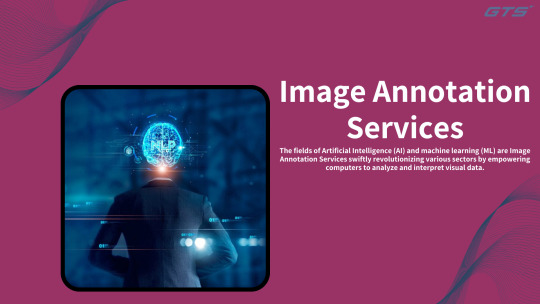
Introduction:
The fields of Artificial Intelligence (AI) and machine learning (ML) are Image Annotation Services swiftly revolutionizing various sectors by empowering computers to analyze and interpret visual data. However, unprocessed images do not offer the structured information necessary for AI to make precise decisions. This is where image annotation services become essential, serving as a link between unrefined image data and valuable AI insights.
Defining Image Annotation
Image annotation involves the process of tagging images with metadata to render them comprehensible for AI algorithms. These tags can identify objects, categorize images, delineate boundaries, or even monitor movements, depending on the specific needs of an AI model. Through accurate annotation, AI systems can identify patterns, recognize objects, and make well-informed decisions with a high degree of precision.
The Significance of Image Annotation for AI
AI models depend on extensive amounts of accurately labeled data for effective learning and enhancement. In the absence of proper image annotation, AI algorithms face challenges in differentiating between objects and accurately interpreting images. The following are some notable advantages of image annotation services:
Increased AI Precision: Well-annotated images facilitate more effective learning for AI, minimizing errors in object detection and classification.
Scalability in AI Development: A substantial volume of labeled data allows AI models to be trained to address a diverse array of real-world situations.
Enhanced Automation: From autonomous vehicles to healthcare diagnostics, annotated images empower AI to automate intricate tasks that necessitate visual recognition.
Improved User Engagement: Technologies such as facial recognition, augmented reality, and e-commerce product suggestions rely on high-quality image annotation to ensure a smooth user experience.
Types of Image Annotation Techniques
Various artificial intelligence applications necessitate distinct annotation techniques. Below are several prevalent types of image annotation utilized in AI training:
Bounding Box Annotation: This method is employed in object detection, where bounding boxes encapsulate objects within an image, facilitating AI in their recognition and classification.
Semantic Segmentation: This approach assigns a label to each pixel in an image, allowing for accurate identification of different areas.
Polygon Annotation: Unlike basic bounding boxes, polygon annotation offers detailed outlines of objects, resulting in more precise labeling.
Keypoint Annotation: This technique is utilized for facial recognition and human pose estimation, marking specific points on an object or human figure.
3D Cuboid Annotation: Vital for applications such as autonomous driving, 3D cuboids enable AI to comprehend depth and spatial relationships.
Applications of Image Annotation Across Industries
Image annotation services play a pivotal role in numerous AI-driven sectors. Some significant applications include:
Autonomous Vehicles: Training self-driving cars to identify pedestrians, traffic signs, and other vehicles.
Healthcare & Medical Imaging: Enhancing AI-based diagnostics through the labeling of X-rays, MRIs, and CT scans.
Retail & E-commerce: Supporting visual search and recommendation systems to improve the shopping experience.
Agriculture: Aiding in crop monitoring, disease detection, and yield estimation through AI-driven analysis.
Security & Surveillance: Enhancing facial recognition and anomaly detection for improved security systems.
Why Opt for Professional Image Annotation Services?
Although some organizations may choose to conduct annotation in-house, utilizing professional image annotation services presents numerous benefits:
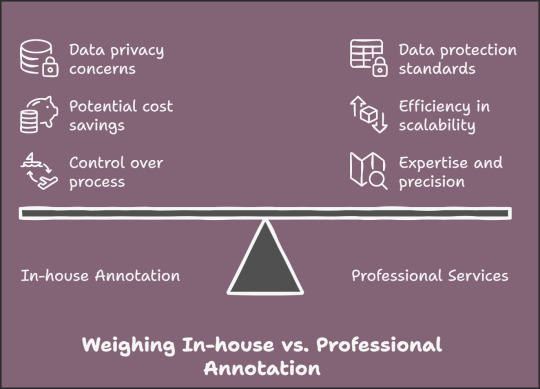
Expertise and Precision: Skilled annotators guarantee accurate labeling, which is crucial for optimal AI functionality.
Efficiency in Time and Costs: By outsourcing annotation tasks, companies can concentrate on AI development while minimizing operational expenses.
Scalability: Professional services are equipped to manage extensive datasets effectively, thereby expediting the AI training process.
Data Protection: Established annotation providers adhere to stringent data privacy standards, safeguarding the confidentiality of sensitive images.
Conclusion
Image annotation services play a vital role in the AI development process, converting unprocessed image data into organized, meaningful information. By connecting raw data with AI insights, these services enable businesses to create more intelligent and efficient AI models across diverse sectors. Whether applied in autonomous vehicles, healthcare, or retail, investing in high-quality image annotation services is a crucial step toward realizing the full potential of AI.
For further information on how image annotation can improve your AI initiative, please visit Globose Technology Solutions AI.
0 notes
Text
Image Data Annotation for Agriculture: Revolutionizing Crop Monitoring
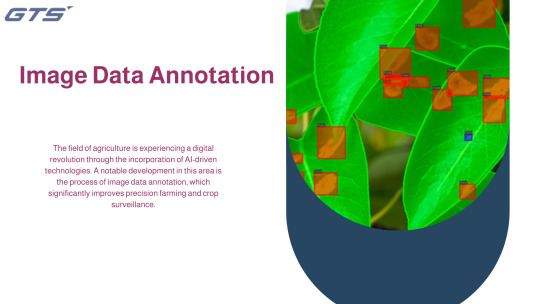
Introduction
The field of agriculture is experiencing a digital revolution through the incorporation of AI-driven technologies. A notable development in this area is the process of Image Data Annotation, which significantly improves precision farming and crop surveillance. Utilizing annotated images from agriculture, AI models are capable of assessing crop health, identifying diseases, and refining yield predictions.
What is Image Data Annotation in Agriculture?
Image data annotation in agriculture refers to the process of labeling visual information, including satellite imagery, drone captures, and photographs of fields, to facilitate the training of machine learning models tailored for agricultural purposes. These annotations enable artificial intelligence systems to detect patterns, classify crop types, and evaluate field conditions with a high degree of precision.
Categories of Image Data Annotation in Agriculture:
1. Bounding Box Annotation – This method identifies plants, weeds, and pests to enable automated detection.
2. Semantic Segmentation – This technique distinguishes between crops, soil, and weeds within an image.
3. Keypoint Annotation – This approach marks essential points on plants to monitor their growth.
4. Polygon Annotation – This method provides accurate outlines of fields and crop areas.
5. 3D Cuboid Annotation – This technique assists in estimating the height and structure of plants.
How Image Data Annotation is Transforming Crop Monitoring
1. Enhanced Crop Health Assessment
AI-driven models utilize annotated images to identify early indicators of diseases, nutrient shortages, and pest problems, allowing farmers to take timely action.
2. Identification of Weeds and Pests
Automated systems for weed detection leverage annotated datasets to differentiate between crops and harmful plants, minimizing the necessity for manual weeding and reducing pesticide application.
3. Yield Forecasting and Harvest Efficiency
Through the analysis of annotated images, AI models can project crop yields, enabling farmers to organize harvest timelines effectively and enhance overall productivity.
4. Targeted Irrigation and Soil Assessment
Image data annotation aids AI-based irrigation systems by monitoring soil moisture and plant hydration levels, promoting efficient water management.
5. Adaptation to Climate and Weather Changes
Utilizing annotated climate and weather data, AI models can foresee unfavorable conditions, assisting farmers in taking preventive actions against droughts or severe weather events.
The Importance of Professional Data Annotation Services
High-quality image annotation services, such as those offered by GTS AI, play a crucial role in the effective training of AI models. These services provide:
Scalability – The ability to manage extensive volumes of agricultural data with efficiency.
Accuracy – Superior annotations that enhance the precision of models.
Cost Efficiency – Minimizing manual labor expenses in the agricultural sector.
Customization – Bespoke annotation solutions tailored to meet specific agricultural requirements.
Conclusion
Image data annotation is revolutionizing the agricultural landscape by facilitating AI-driven crop monitoring, disease identification, and yield forecasting. As technological advancements continue, precision farming will further develop, equipping farmers with data-informed insights for sustainable agricultural practices.
For innovative image annotation solutions, consider GTS AI to transform your agricultural AI models today.
0 notes
Text
Shaping Smarter Machines: Image Annotation in the Digital Era
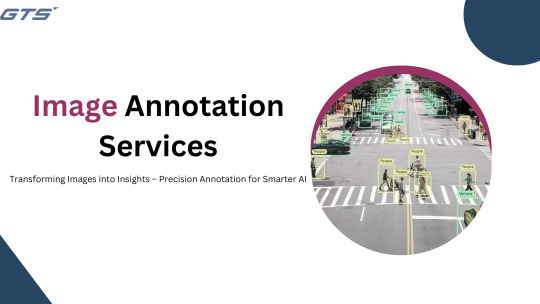
Introduction:
In the contemporary digital landscape, the distinction between human intelligence and artificial intelligence (AI) is increasingly indistinct as machines evolve to become more intelligent, rapid, and efficient. Central to this evolution is a vital yet frequently overlooked process: Image Annotation Services . This detailed practice forms the foundation of AI’s capacity to analyze, comprehend, and react to visual information. This article will delve into the essential function of image annotation in the development of advanced machines and its influence on the future of technology.
What Is Image Annotation?
Image annotation refers to the technique of tagging images with metadata to render them comprehensible to machines. This process includes marking objects, identifying characteristics, or delineating boundaries within an image, thereby converting raw data into formats that machines can interpret. These annotations provide the training data necessary for machine learning models, particularly in domains such as computer vision, where the ability to understand visual content is critical.
Common types of image annotation encompass:
Bounding Boxes: Drawing rectangles around objects to indicate their position.
Semantic Segmentation: Segmenting an image into parts to assign labels to individual pixels.
Polygons: Outlining intricate shapes for precise object detection.
Keypoint Annotation: Identifying specific points, such as facial features or joint locations.
3D Cuboids: Extending bounding boxes into three dimensions for depth analysis. Each type of annotation is tailored to specific machine learning applications, enabling AI systems to recognize faces, detect objects, or even facilitate the navigation of autonomous vehicles.
The Significance of Image Annotation
Annotated data is essential for AI systems, as it provides the necessary context to interpret visual information effectively. Without it, machines face challenges similar to navigating an unfamiliar country without a map or language comprehension. Image annotation serves as a crucial link by supplying structured and labeled data, allowing machines to recognize patterns and relationships.
The primary advantages of image annotation include:
Improving Accuracy: Annotated datasets enhance the precision of models, thereby minimizing errors in tasks such as object detection and image classification.
Preparing AI for Practical Use: From self-driving vehicles to medical imaging, annotated images equip AI systems for real-world applications.
Facilitating Scalability: High-quality annotations enable the expansion of AI applications across various industries.
The Role of Image Annotation in Contemporary Digital Applications
The influence of image annotation extends across multiple sectors, acting as a catalyst for innovative advancements:
Autonomous Vehicles: Self-driving technology depends on annotated images to recognize pedestrians, vehicles, traffic signs, and road boundaries. This annotation is vital for enabling these systems to make rapid decisions, thereby improving safety and operational efficiency.
Healthcare: In the realm of medical imaging, annotated data assists AI models in identifying diseases such as cancer and diabetic retinopathy. Collaboration between radiologists and data scientists is essential for labeling anomalies in scans, which leads to faster and more accurate diagnoses.
E-Commerce: Retailers utilize image annotation for tailored recommendations, visual search capabilities, and inventory management. For instance, AI can analyze user-uploaded photos to identify clothing items and suggest similar products.
Agriculture: Annotated images play a significant role in monitoring crop health, identifying pests, and maximizing yields. Drones equipped with AI technology analyze annotated visual data to deliver actionable insights to farmers.
Security and Surveillance: Annotated images are integral to facial recognition systems and anomaly detection in security cameras, enhancing monitoring capabilities.
Challenges in Image Annotation
The significance of image annotation is clear; however, it presents several challenges:
Labor-Intensive Nature: The process of annotating extensive datasets demands considerable time and careful attention to detail.
Financial Implications: Engaging professional annotation services can incur substantial costs, particularly for intricate tasks.
Variability in Interpretation: Different human annotators may perceive images in various ways, resulting in inconsistencies.
Scalability Concerns: As datasets expand, ensuring quality and uniformity becomes progressively more difficult.
Addressing these challenges necessitates a blend of proficient annotators, advanced technological tools, and comprehensive quality assurance measures. The integration of automation and semi-automated tools, driven by artificial intelligence, is increasingly vital in optimizing annotation workflows.
The Future of Image Annotation
With the ongoing advancement of AI, the domain of image annotation is also evolving. Several trends are influencing its future:
AI-Enhanced Annotation: Tools that utilize AI can automatically pre-label images, minimizing manual labor and accelerating the annotation process. Human annotators subsequently refine these initial labels to ensure precision.
Crowdsourced Solutions: Platforms such as Amazon Mechanical Turk facilitate distributed annotation efforts, leveraging a global workforce to efficiently manage large datasets.
Synthetic Data Generation: The creation of synthetic images, along with programmatic annotation, can supplement real-world datasets, thereby decreasing reliance on manual annotation.
Specialized Annotation Services: Emerging services focused on specific industries are ensuring that annotations align with particular requirements.
Real-Time Annotation Capabilities: As applications requiring real-time AI, such as augmented reality and live surveillance, become more prevalent, the demand for real-time annotation functionalities is increasing.
Conclusion
Image annotation transcends mere technicality; it serves as the cornerstone for the development of advanced machines. By converting visual information into practical insights, it allows artificial intelligence systems to interpret and engage with their environment in groundbreaking manners. As we progress further into the digital age, the necessity for superior image annotation services is expected to escalate, fostering innovation across various sectors and paving the way for a future where intelligent machines are seamlessly woven into our daily lives.
Selecting the right image annotation service is crucial for the success of computer vision projects. Collaborating with experts like Globose Technology Solutions ensures high-quality annotations tailored to project needs, boosting model performance and efficiency. Opting for specialized providers combines expertise with scalability, making them ideal for handling complex datasets.
0 notes
Text
What Is an Image Annotation Company and Why You Need One
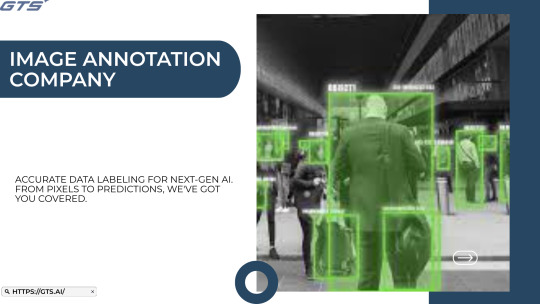
Introduction
In the era of artificial intelligence (AI), data has become the new oil; however, unprocessed data by itself will not yield effective outcomes. It requires refinement, organization, and labeling to gain value. This is where image annotation firms are crucial. Whether you are developing a self-driving vehicle to identify pedestrians, assisting a medical AI in tumor detection, or enhancing facial recognition technologies, accurately annotated images are necessary. Let us explore the functions of an Image Annotation Company and the importance of collaborating with one for achieving success in AI.
What Is Image Annotation?
Image annotation involves the labeling of images with pertinent metadata to enhance their comprehensibility for machine learning algorithms. This may include tasks such as drawing bounding boxes around vehicles, delineating organs in medical imaging, pinpointing key positions in human movement, or segmenting objects at the pixel level. These annotations enable AI models to 'perceive' and interpret the visual environment with precision, akin to the way humans utilize their eyes and cognitive processes.
What Does an Image Annotation Company Do?
A company specializing in image annotation offers expert services to accurately and consistently label large quantities of images and videos. They utilize skilled human annotators, AI-enhanced tools, and stringent quality assurance measures to produce labeled datasets customized for particular AI applications.
The services generally encompass: bounding box annotation,
polygon and polyline annotation,
semantic and instance segmentation,
3D point cloud labeling,
video frame annotation,
and keypoint and landmark detection.
Organizations such as GTS.AI provide comprehensive image and video annotation services to enhance AI training across various sectors.
Why You Need an Image Annotation Company
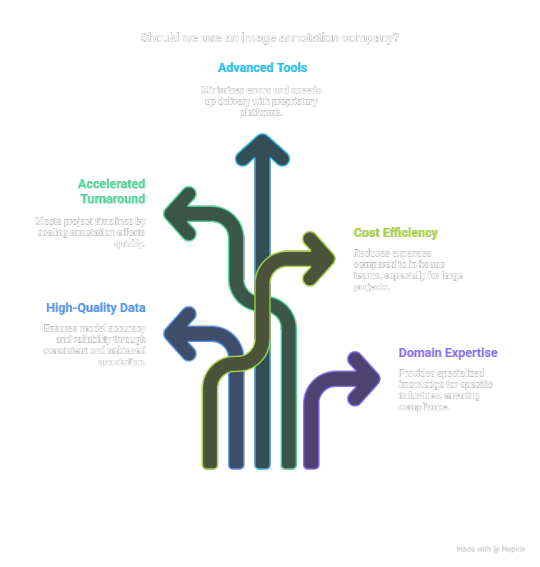
When developing AI or machine learning models that utilize visual data, annotation is not merely an option — it is a necessity. Here are the reasons why collaborating with a specialized company is crucial:
High-Quality, Consistent Data
The precision of your model is contingent upon the quality of your training data. Skilled annotators guarantee consistency and mitigate bias, leading to more dependable AI systems.
Accelerated Turnaround at Scale
Labeling thousands (or millions) of images internally is labor-intensive and time-consuming. Image annotation firms can rapidly scale their efforts to adhere to stringent project timelines.
3. Advanced Tools & Infrastructure
Professional organizations employ proprietary platforms equipped with automation capabilities, quality assurance measures, and data protection — all of which minimize errors and expedite delivery.
Cost Efficiency
Establishing an in-house annotation team can incur significant expenses. Outsourcing to a specialized partner frequently proves to be more effective, particularly for large-scale or ongoing initiatives.
Domain-Specific Expertise
Sectors such as healthcare, autonomous vehicles, and retail often necessitate specialized knowledge for annotation. A professional image annotation company provides that domain expertise, ensuring precision and compliance.
The Bottom Line
When investing in computer vision or AI development, the quality of your training data is crucial to your success. A dependable image annotation company offers the necessary tools, expertise, and technology to efficiently and accurately prepare your data. If you seek a reliable partner for your image and video annotation requirements, consider our services at Globose Technology Solution .AI to discover how we facilitate data labeling on a large scale across various industries, use cases, and technologies.
0 notes
Text
[ad_1] embedUR systems, a leader in embedded solutions and Edge AI technologies, is proud to join STMicroelectronics’ Authorized Partner program. By leveraging ST's hardware and software ecosystem, embedUR systems has developed three advanced Edge AI applications for the STM32N6 platform. These applications demonstrate the transformative potential of AI on efficient, compact hardware across diverse industries. Through this collaboration, embedUR systems not only optimized AI models but also developed, trained, and integrated them to run on ST’s latest STM32N6 microcontrollers complete with the embedded software stack needed for productization. By leveraging deep expertise in STMicroelectronics’ platforms, embedUR is enabling innovative Edge AI applications that pave the way for transformative industry solutions. Edge AI Solutions People Detection with Image Segmentation embedUR delivers a state-of-the-art Image Segmentation solution for high-speed detection and classification of individuals. This functionality is well-suited for applications such as occupancy counting, presence detection, crowd management, person following and more. This capability combines: Adaptation of YOLACT for Neural-ART Accelerator™, the STM32N6’s Neural Processing Unit (NPU): supporting real-time instance segmentation, YOLACT has been optimized for the STM32N6 hardware, ensuring low latency and robust performance. Proprietary optimization techniques: embedUR’s advanced quantization strategies shrink model size by nearly 75% while maximizing speed and accuracy, making it ideal for resource-constrained devices. Enhanced image quality through STM32N6’s Image Signal Processor (ISP): this integration ensures reliable performance across varying lighting conditions and enables the solution to run at 71 FPS. Facial Recognition with Enrollment embedUR’s on-device facial recognition solution combines security and high-speed processing, making it ideally suited to biometric boarding at airports or keyless entry systems, which require stringent standards of security, privacy and performance. Features include: embedUR’s UReyeD framework: Enables precise facial detection, keypoint extraction, and embedding generation for fast, accurate recognition. Direct on-device enrollment: Eliminating the need for external infrastructure, this feature enhances privacy and simplifies deployment. Support for large-scale databases with rapid identification: Designed for environments with high user throughput, such as access control and public safety. Audio Denoising embedUR systems has also created an audio denoising solution that runs on STM32N6’s Neural-ART Accelerator (NPU). It incorporates the excellent audio capabilities of the STM32N6 platform with a state-of-the-art audio denoising model to deliver clear speech, even in noisy environments. As systems add speech to text to feed LLMs, denoising will be increasingly used to ensure that LLMs are fed with the most accurate transcription. Notable characteristics: embedUR chose an award-winning audio denoising model designed to run on GPUs and then adapted and optimized this for the NPU on the STN32N6. Running the model on the STM32N6 NPU reduces power consumption, increases accuracy, and removes latency needed to make the audio solution work in a variety of high demand and low power environments Driving Innovation in Edge AI “This collaboration with STMicroelectronics is a testament to our engineering excellence and ability to bring up AI solutions rapidly and independently on literally any Edge platform (CPU/GPU/NPU),” said Rajesh Subramaniam, CEO of embedUR systems. “We’re proud to demonstrate how efficient, high-performance AI solutions can be realized on the STM32N6 microcontroller, and the myriad applications they can enable.” "embedUR systems has demonstrated
expertise in creating AI technology and optimizing it for our STM32N6 microcontroller, with minimal support required from our engineering teams. Their experience, creativity and efficiency are extraordinary. In a few short weeks, they have been able to demonstrate the incredible potential of edge AI on STMicroelectronics’ components to drive transformative AI solutions across industries." said Miguel Castro, head of AI strategy & business dev for Americas at STMicroelectronics. “We are pleased to announce that embedUR is a new ST Authorized Partner.” embedUR systems invites businesses to explore how its expertise and solutions can enable the next generation of Edge AI applications. To learn more, visit www.embedur.ai. About embedUR systems embedUR systems is a Silicon Valley-based leader in embedded systems, AI, and Edge Computing. With over two decades of expertise and a proven track record of accelerating product time-to-market for telecom, network equipment, and silicon vendors, embedUR delivers cutting-edge embedded solutions powering millions of devices worldwide. Its ModelNova platform offers pre-trained AI models for seamless integration into intelligent edge systems, enabling AI enthusiasts and afficionados alike to experiment with AI and easily develop proof of concepts with little to no AI modeling expertise, in record time. Browse pre-trained Edge AI models today at modelnova.ai. !function(f,b,e,v,n,t,s) if(f.fbq)return;n=f.fbq=function()n.callMethod? n.callMethod.apply(n,arguments):n.queue.push(arguments); if(!f._fbq)f._fbq=n;n.push=n;n.loaded=!0;n.version='2.0'; n.queue=[];t=b.createElement(e);t.async=!0; t.src=v;s=b.getElementsByTagName(e)[0]; s.parentNode.insertBefore(t,s)(window,document,'script', 'https://connect.facebook.net/en_US/fbevents.js'); fbq('init', '311356416665414'); fbq('track', 'PageView'); [ad_2] Source link
0 notes
Text
[ad_1] embedUR systems, a leader in embedded solutions and Edge AI technologies, is proud to join STMicroelectronics’ Authorized Partner program. By leveraging ST's hardware and software ecosystem, embedUR systems has developed three advanced Edge AI applications for the STM32N6 platform. These applications demonstrate the transformative potential of AI on efficient, compact hardware across diverse industries. Through this collaboration, embedUR systems not only optimized AI models but also developed, trained, and integrated them to run on ST’s latest STM32N6 microcontrollers complete with the embedded software stack needed for productization. By leveraging deep expertise in STMicroelectronics’ platforms, embedUR is enabling innovative Edge AI applications that pave the way for transformative industry solutions. Edge AI Solutions People Detection with Image Segmentation embedUR delivers a state-of-the-art Image Segmentation solution for high-speed detection and classification of individuals. This functionality is well-suited for applications such as occupancy counting, presence detection, crowd management, person following and more. This capability combines: Adaptation of YOLACT for Neural-ART Accelerator™, the STM32N6’s Neural Processing Unit (NPU): supporting real-time instance segmentation, YOLACT has been optimized for the STM32N6 hardware, ensuring low latency and robust performance. Proprietary optimization techniques: embedUR’s advanced quantization strategies shrink model size by nearly 75% while maximizing speed and accuracy, making it ideal for resource-constrained devices. Enhanced image quality through STM32N6’s Image Signal Processor (ISP): this integration ensures reliable performance across varying lighting conditions and enables the solution to run at 71 FPS. Facial Recognition with Enrollment embedUR’s on-device facial recognition solution combines security and high-speed processing, making it ideally suited to biometric boarding at airports or keyless entry systems, which require stringent standards of security, privacy and performance. Features include: embedUR’s UReyeD framework: Enables precise facial detection, keypoint extraction, and embedding generation for fast, accurate recognition. Direct on-device enrollment: Eliminating the need for external infrastructure, this feature enhances privacy and simplifies deployment. Support for large-scale databases with rapid identification: Designed for environments with high user throughput, such as access control and public safety. Audio Denoising embedUR systems has also created an audio denoising solution that runs on STM32N6’s Neural-ART Accelerator (NPU). It incorporates the excellent audio capabilities of the STM32N6 platform with a state-of-the-art audio denoising model to deliver clear speech, even in noisy environments. As systems add speech to text to feed LLMs, denoising will be increasingly used to ensure that LLMs are fed with the most accurate transcription. Notable characteristics: embedUR chose an award-winning audio denoising model designed to run on GPUs and then adapted and optimized this for the NPU on the STN32N6. Running the model on the STM32N6 NPU reduces power consumption, increases accuracy, and removes latency needed to make the audio solution work in a variety of high demand and low power environments Driving Innovation in Edge AI “This collaboration with STMicroelectronics is a testament to our engineering excellence and ability to bring up AI solutions rapidly and independently on literally any Edge platform (CPU/GPU/NPU),” said Rajesh Subramaniam, CEO of embedUR systems. “We’re proud to demonstrate how efficient, high-performance AI solutions can be realized on the STM32N6 microcontroller, and the myriad applications they can enable.” "embedUR systems has demonstrated
expertise in creating AI technology and optimizing it for our STM32N6 microcontroller, with minimal support required from our engineering teams. Their experience, creativity and efficiency are extraordinary. In a few short weeks, they have been able to demonstrate the incredible potential of edge AI on STMicroelectronics’ components to drive transformative AI solutions across industries." said Miguel Castro, head of AI strategy & business dev for Americas at STMicroelectronics. “We are pleased to announce that embedUR is a new ST Authorized Partner.” embedUR systems invites businesses to explore how its expertise and solutions can enable the next generation of Edge AI applications. To learn more, visit www.embedur.ai. About embedUR systems embedUR systems is a Silicon Valley-based leader in embedded systems, AI, and Edge Computing. With over two decades of expertise and a proven track record of accelerating product time-to-market for telecom, network equipment, and silicon vendors, embedUR delivers cutting-edge embedded solutions powering millions of devices worldwide. Its ModelNova platform offers pre-trained AI models for seamless integration into intelligent edge systems, enabling AI enthusiasts and afficionados alike to experiment with AI and easily develop proof of concepts with little to no AI modeling expertise, in record time. Browse pre-trained Edge AI models today at modelnova.ai. !function(f,b,e,v,n,t,s) if(f.fbq)return;n=f.fbq=function()n.callMethod? n.callMethod.apply(n,arguments):n.queue.push(arguments); if(!f._fbq)f._fbq=n;n.push=n;n.loaded=!0;n.version='2.0'; n.queue=[];t=b.createElement(e);t.async=!0; t.src=v;s=b.getElementsByTagName(e)[0]; s.parentNode.insertBefore(t,s)(window,document,'script', 'https://connect.facebook.net/en_US/fbevents.js'); fbq('init', '311356416665414'); fbq('track', 'PageView'); [ad_2] Source link
0 notes
Text
What to Expect from a Leading Image Annotation Company
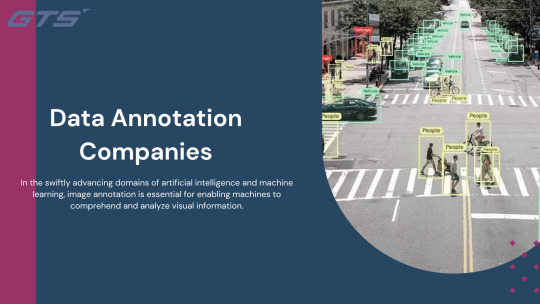
Introduction:
In the swiftly advancing domains of artificial intelligence and machine learning, image annotation is essential for enabling machines to comprehend and analyze visual information. For organizations engaged in developing AI models, collaborating with a premier image annotation firm can significantly impact their success. However, what distinguishes the top companies in this field? Here are the key attributes you should anticipate from a high-caliber image annotation service provider.
Proficiency in Various Annotation Methods
A premier Image Annotation Company should provide an extensive array of annotation services customized for different industries and applications. These services may encompass:
Bounding Boxes: Ideal for object detection and localization.
Semantic Segmentation: Involves assigning pixel-level labels to objects for sophisticated applications such as autonomous driving.
Keypoint Annotation: Suitable for facial recognition and human pose estimation.
Polygon Annotation: Effective for annotating irregular shapes within images.
3D Point Cloud Annotation: Essential for processing LiDAR data in robotics and autonomous vehicles.
Such comprehensive proficiency guarantees that your specific project needs are addressed with accuracy.
Scalability and Rapid Turnaround
Reputable annotation firms recognize the importance of time in AI development. They possess the necessary infrastructure and resources to manage large-scale annotation projects without sacrificing precision. Whether dealing with thousands or millions of images, they should be capable of scaling their operations and delivering results within the established timelines.
Cutting-Edge Tools and Technology
Leading firms utilize advanced annotation tools and software to ensure both efficiency and accuracy. They may also employ AI-assisted annotation platforms to expedite the labeling process while upholding high-quality standards. Seek providers that prioritize investment in innovative technology to optimize workflows and improve output.
Rigorous Quality Assurance Protocols
Accuracy is essential in image annotation. A premier company will establish comprehensive quality control protocols, including multi-tiered reviews and automated verification processes, to reduce the likelihood of errors. Anticipate thorough testing procedures to guarantee that the annotated data aligns with the specific requirements of your project.
Tailored Solutions
Each AI project possesses its own distinct characteristics, and a top-tier image annotation firm recognizes this. They should be capable of customizing their offerings to meet your particular needs, whether that entails following stringent guidelines, managing sensitive information, or integrating seamlessly with your current systems and workflows.
Data Protection and Privacy
In the context of proprietary or sensitive information, security is imperative. Leading firms emphasize data protection by employing secure systems, complying with international standards (such as GDPR), and entering into non-disclosure agreements (NDAs). Their dedication to privacy ensures that your data remains secure throughout the annotation process.
Skilled Workforce
A proficient team of annotators and project managers is the backbone of every successful annotation initiative. Top companies recruit trained professionals who possess experience in managing a variety of datasets. Their knowledge contributes to maintaining consistency and precision, even in intricate annotation assignments.
Open Communication and Support
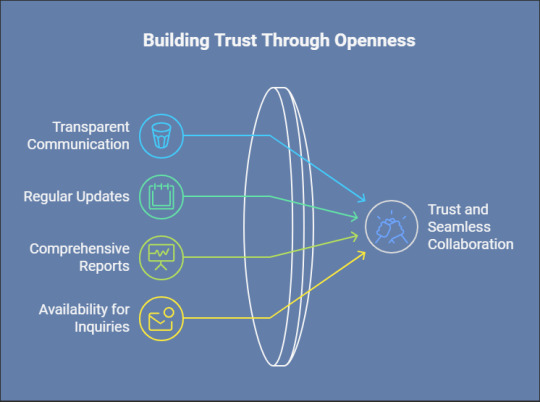
A trustworthy image annotation partner prioritizes transparent and effective communication. They offer regular updates, comprehensive reports, and are readily available to address any inquiries without delay. This level of openness fosters trust and facilitates a seamless collaboration.
Affordable Services
While maintaining quality is paramount, leading companies also aim to provide competitive pricing. By streamlining their operations and utilizing advanced technologies, they offer high-quality annotation services at a reasonable price, ensuring excellent value for your investment.
A Demonstrated History of Success
In conclusion, a reputable image annotation firm will possess a track record of completed projects and contented clients. It is advisable to seek out case studies, client testimonials, and examples from their portfolio that highlight their proficiency and capability to achieve results across diverse sectors.
Conclusion
Collaborating with a distinguished image annotation company such as GTS.AI can greatly improve the effectiveness of your AI models. By providing specialized knowledge, scalability, cutting-edge tools, and a dedication to quality, these firms lay the groundwork for successful AI and machine learning endeavors. It is essential to select a partner who fulfills these criteria and aligns with the objectives of your project to ensure optimal results.
For those seeking a reliable collaborator in image annotation, GTS AI provides extensive services customized to meet your specific requirements. With proficiency in multiple fields and a dedication to quality, GTS AI guarantees that your AI models attain exceptional performance.
0 notes